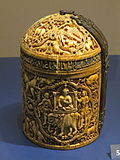User:PastaRL/Pyxis (vessel)
This article needs additional citations for verification. (November 2011) |

A pyxis (Greek: πυξίς; pl.: pyxides) is a shape of vessel from the classical world, usually a cylindrical box with a separate lid and no handles[1]. They were used to hold cosmetics, trinkets or jewellery, but were also used for dispensing incense and by physicians to contain medicine.[2] Surviving pyxides are mostly Greek pottery, but could also be made from a range of other materials: wood, bronze, ivory, marble, terracotta, silver, or stone.[3] The name derived from Corinthian boxes made of wood from the tree puksos ("boxwood").[3] During the Classical period, the Attic word "kylichnis" was also used to refer to the same shape.[3] The shape of the vessel can be traced in pottery back to the Protogeometric period in Athens, however the Athenian pyxis has various shapes itself.
Types
[edit]Different kinds and style of Pyxis were popular in varying times throguhout history. The earliest were the Protogeometric type of vessel which had a globular body, and the pointed-bottom pyxis from the early Geometric period.[4] The pointed pyxis didn't last much longer than the ninth century BCE. During the later Geometric period another style emerged with a flat, very broad base.[5] Contemporary scholarship classifies pyxides as either: type A, type B, type C, type D, lekanis, Nikosthenic, or tripod.[6]
Nikosthenic type
[edit]
This type was introduced by the potter Nikosthenes, of which the style was named after, during the late sixth century BCE. It is characterised by a deep, calyx-shaped bowl with a flanged rim and a stemmed foot, topped with a domed lid.[7][8] The decorations on pyxides found in an Etruscan context tend towards depictions of battles and athletic contests; for pyxides found in Greek and near eastern Mediterranean settings the depictions tend to be of marriage, childbirth, or religious processions.[9] Evidence suggests that this was a popular type on the eastern Aegean island of Samos and in Etruria between 560–500 BCE.[10]
Proto-Geometric type
Examples of pyxide from the Proto-Geometric style of Greek pottery normaly between roughly 1050 and 900 BCE[11][12][13] include the Globular Pyxis, a type of pyxis characterized with a wide, circular body and a flared lip at the top of the vessel.[14] Other forms of pyxide commonly from the early geometric period include the pointed pyxis is a type of pyxis characteried with a wide tip that thins into a point at the bottom.[15]
Conrinthian type
Corinthian style pyxides usually share similar traits of being less circular than traditional Greek geometric style pyxides. We can see this in the tall convex pyxis,[16] and the 8th century straight-sided pyxis[17] Corinthian styles. Other forms of Corintian pyxyde inclue the Type II: Low Concave-sided pyxis[18] dated around the 5th and 4th centuries BC and the Type III: High Concave-sided pyxis[19] dated ca. late 7th century BC
Gallery
[edit]-
Circular pyxis, 5th Century, Walters Art Museum
-
A Roman luxury Pyxis, used to hold cosmetics or precious jewellery - Walters Art Museum
-
4th century Athenian pyxis with a depiction of a hand, National Museum, Warsaw
-
Ivory pyxis from Córdoba, Spain, 10th Century AD, Victoria and Albert Museum
-
Pyxis with four horses, Greece, Attica, Geometric Period, 8th century BC, terracotta - Wadsworth Atheneum - Hartford, CT
-
Example of a Type A Pyxis - Clay pyxis with lid, Protogeometric Period, 10th c. BC
-
Example of a "Type II", Low Concave-sided, Pyxis c. 400 B.C. - Metropolitan Museum of Arts
See also
[edit]References
[edit]- ^ [1]Folsom, Robert (1967). Handbook Of Greek Pottery. p. 183.
{{cite book}}: CS1 maint: date and year (link) - ^ Roberts 1978, p. 4.
- ^ a b c Roberts 1978, p. 2.
- ^ Folsom 1967, p. 180. sfn error: multiple targets (2×): CITEREFFolsom1967 (help)
- ^ Folsom 1967, p. 181. sfn error: multiple targets (2×): CITEREFFolsom1967 (help)
- ^ Perseus Encyclopedia, Pyxis
- ^ Lemos, Irene S (2003-01-09), "Protogeometric Pottery Found in the Eastern Mediterranean", The Protogeometric Aegean, Oxford University PressOxford, pp. 228–229, ISBN 978-0-19-925344-9, retrieved 2024-06-11
- ^ Lemos 2002, p. 2 :"...the Aegean from the period around 1050/25 to around 900 BC, named after its characteristic 'Protogeometric' pottery style.".
- ^ Lyons 2009, p. 171.
- ^ Lyons 2009, p. 173.
- ^ "Protogeometric style", Wikipedia, 2024-04-14, retrieved 2024-06-11
- ^ "Protogeometric style", Wikipedia, 2024-04-14, retrieved 2024-06-11
- ^ Sparkes, Brian A. (1991). Greek pottery : an introduction. Internet Archive. Manchester ; New York : Manchester University Press ; New York : Distributed exclusively in the USA and Canada by St. Martin's Press. ISBN 978-0-7190-2236-4.
- ^ ROBERT FOLSOM (1967). Handbook Of Greek Pottery ( 1967] By ROBERT FOLSOM.
- ^ ROBERT FOLSOM (1967). Handbook Of Greek Pottery ( 1967] By ROBERT FOLSOM.
- ^ ROBERT FOLSOM (1967). Handbook Of Greek Pottery ( 1967] By ROBERT FOLSOM.
- ^ ROBERT FOLSOM (1967). Handbook Of Greek Pottery ( 1967] By ROBERT FOLSOM.
- ^ R., G. M. A. (1908-08). "White Athenian Pyxis". The Metropolitan Museum of Art Bulletin. 3 (8): 154. doi:10.2307/3252705. ISSN 0026-1521.
{{cite journal}}: Check date values in:|date=(help) - ^ ROBERT FOLSOM (1967). Handbook Of Greek Pottery ( 1967] By ROBERT FOLSOM.
Bibliography
[edit]- Roberts, Sally (1978). The Attic Pyxis. Ares Publishers.
- Folsom, Robert (1967). Handbook Of Greek Pottery. New York Graphic Society Ltd.
- Lyons, Claire (2009). "Nikosthenic pyxides between Etruria and Greece". In Oakley, John; Palagia, Olga (eds.). Athenian Potters and Painters Volume II. Oxbow Books. pp. 166–180. ISBN 978-1-84217-350-3.
- Sparkes, Brian A. (1991). Greek Pottery: An Introduction. Manchester ; New York : Manchester University Press ; New York : Distributed exclusively in the USA and Canada by St. Martin's Press
- Dickinson, Oliver (1994). The Aegean Brone Age. Cambridge University Press








